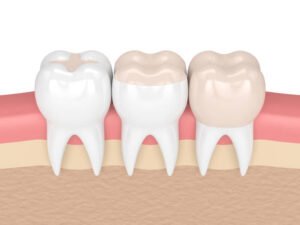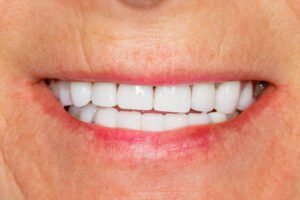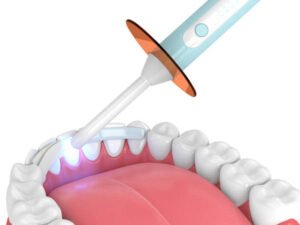If you have gum disease, you might wonder if you can still get composite bonding. Composite bonding is a popular cosmetic dental procedure that improves the appearance of your teeth. But is it safe to have this treatment if you have gum disease? Let’s explore this question and provide you with all the information you need.
Understanding Gum Disease
Before we discuss composite bonding, it’s important to understand what gum disease is. Gum disease, also known as periodontal disease, affects the gums and the structures supporting your teeth. It usually starts with gingivitis, which is the inflammation of the gums. If left untreated, gingivitis can turn into periodontitis, a more severe form of gum disease.
Gum disease is caused by plaque, a sticky film of bacteria that forms on your teeth. Plaque can lead to inflammation and infection of the gums. Common symptoms include redness and swelling. They also include bleeding gums and bad breath. In advanced cases, they cause loose teeth and tooth loss.
Composite Bonding and Gum Disease
So, can you have composite bonding with gum disease? The answer depends on the severity of your gum disease.
- Mild Gingivitis: If you have mild gingivitis, you can still have composite bonding. However, it’s important to treat the gum disease first. Your dentist will recommend cleanings. They will also recommend better oral care and lifestyle changes. These things will help manage and eliminate gingivitis.
- periodontitis, composite bonding might not be safe. Wait until your gum disease is under control. Periodontitis can cause gum recession and bone loss. It can also make teeth wobbly. These issues need to be fixed before any cosmetic procedures.
The Role of a Dentist
It’s crucial to consult with a dentist to determine if composite bonding is suitable for you. The dentist will assess the condition of your gums and teeth, take X-rays if needed, and create a treatment plan tailored to your needs.
Addressing Gum Disease
To increase your chances of being a candidate for composite bonding, here are some steps to manage and treat gum disease:
- Regular Dental Check-ups: Visit your dentist regularly for check-ups and cleanings. Professional cleanings can remove plaque and tartar buildup, reducing the risk of gum disease.
- Good Oral Hygiene: Maintain a consistent oral hygiene routine. Brush your teeth at least twice a day, floss daily, and use an antiseptic mouthwash.
- Lifestyle Changes: If you smoke, consider quitting, as smoking is a significant risk factor for gum disease. Managing conditions like diabetes can also reduce your risk.
- Diet: Eat a balanced diet rich in fruits and vegetables to support healthy gums and overall oral health.
Composite Bonding Procedure
If your dentist determines that you’re a suitable candidate for composite bonding, here’s what to expect from the procedure:
- Consultation: The process begins with a consultation. You and your dentist will discuss your goals and expectations for composite bonding.
- Tooth Preparation: Minimal tooth preparation is required. The dentist will roughen the surface of the tooth slightly to ensure the composite resin bonds properly.
- Bonding Material: The dentist will select a shade of composite resin that closely matches your natural teeth.
- Application: The composite resin is applied to the tooth and shaped to achieve the desired result. A special curing light is used to harden the resin.
- Finishing Touches: Once the resin hardens, your dentist will trim and polish it to create a seamless and natural appearance.
Composite Bonding Benefits
Composite bonding offers several benefits, including:
- Cosmetic Improvement: It can enhance the appearance of chipped, cracked, or discolored teeth.
- Minimal Tooth Removal: Other cosmetic procedures are different. They remove more of your natural tooth.
- Quick Results: The procedure is typically completed in a single visit, providing immediate results.
Preventive Measures
Composite bonding can fix looks. But, to stay healthy, you must prevent gum disease. Here are some preventive measures:
- Brush and Floss Regularly: Maintain good oral hygiene by brushing twice daily and flossing to remove plaque.
- Use Antiseptic Mouthwash: Rinse with mouthwash to kill bacteria that can cause gum disease.
- Regular Dental Visits: See your dentist regularly for check-ups and cleanings to catch any early signs of gum disease.
- Healthy Diet: Eat a balanced diet with plenty of fruits and vegetables to support gum health.
Conclusion
In conclusion, whether you can have composite bonding with gum disease depends on the severity of your condition. Mild gingivitis allows for bonding. But, advanced periodontitis must be managed before considering cosmetics. Consulting with a dentist is essential to assess your situation and develop a suitable treatment plan.
Maintaining good oral hygiene practices and regular dental check-ups are vital for healthy gums and teeth. By treating gum disease and following your dentist’s advice, you can better qualify for composite bonding. It will help you get the smile you want.
Visit Old Town Dental Care for Expert Advice
If you’re considering composite bonding but are concerned about gum disease, visit Old Town Dental Care. Our experienced dentists will assess your oral health, provide tailored treatment plans, and guide you through the best options to achieve a healthy, beautiful smile. Schedule your consultation today and take the first step towards better dental health!
Frequently Asked Questions
Can composite bonding help with gum recession?
Yes, bonding can cover exposed tooth roots from gum recession. It improves the appearance and reduces sensitivity.
How long does composite bonding last?
Composite bonding typically lasts 3 to 10 years. The duration depends on your oral hygiene and habits. For example, chewing hard foods or grinding your teeth.
3. Is composite bonding painful?
No, composite bonding is usually painless. The procedure is minimally invasive, and dentists often use local anaesthesia to ensure comfort.
Can I eat normally after composite bonding?
Yes, you can eat normally after the procedure. However, avoid hard or sticky foods for the first few days to protect the bonding material.
How do I care for my teeth after composite bonding?
Keep good oral hygiene. Brush twice a day and floss daily. Also, see your dentist for check-ups and cleanings. Avoid foods and habits that stain. These include smoking. They can keep your bonded teeth looking their best.







